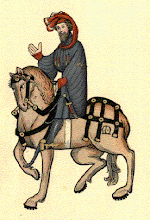Recently Pete brought "Living HEMA" (http://www.livinghema.se/index.html) to my attention. For those of you who don't read Swedish here is the translation of one of their pages:
"What is HEMA
HEMA is an abbreviation of the Historical European Martial Arts, in Swedish historical European martial arts.
This is a collective name for the old traditions of often extinct or nearly extinct martial arts that are recorded and documented from historical times. During the late 1800s and early 1900s brought a renewed interest in these forms of struggle, and then again in large forgotten. Over the past 10-15 years has once again created interest and pursue the study of historical martial arts.
Some of the most common areas of interest today revolves around the medieval martial arts, as practiced, say, Germany and Italy, but the concept of historical European martial art involving a much larger collection of martial arts. The term comes from English Historical European Martial Arts (HEMA, an acronym which is also used in Swedish) and encloses often forms of struggle are still alive, but on a reduced scale, for example, bare Knuckle boxing, Canne de combat, or the like.
Many of the older manuscripts contain detailed descriptions of both individual techniques and the whole system." (many thanks to Google Translate for this. http://translate.google.com/#sv|en|).
Now, I am honestly a bit divided on this. On the one hand I am encouraged to see quality living history interpreters adding HEMA to their displays and yet on the other hand I wonder if the historical clothing truly adds or detracts from the public's view of HEMA. In the end I think that I would rather see a proper display of HEMA (with true martial intent) by reenactors in costume than the "fives" anyday.
Monday, 26 July 2010
Sunday, 4 July 2010
Back to basics
Its time to take things back to basics folks. A time to consider what we know, what needs work and what must yet be explored.
For the moment let's begin with how we hold a longsword (or any sword really). Recently I have noticed a tendency to grip far too tightly...we must loosen our grip, we need to relax.
First of all we must stop holding our swords in a “fist” grip. It is inelegant, overly tiring, leads to poor responses and reduces the effectiveness of your cut. A proper grip goes a long way to vastly improve your offensive and defensive skills. What we are looking for here is a kind of “handshake” grip with the top right hand, with bottom left hand mostly on the pommel. This allows the bottom hand to move as needed depending on position, allowing the pommel to rotate around yet stays mostly on the pommel.
For the moment let's begin with how we hold a longsword (or any sword really). Recently I have noticed a tendency to grip far too tightly...we must loosen our grip, we need to relax.
First of all we must stop holding our swords in a “fist” grip. It is inelegant, overly tiring, leads to poor responses and reduces the effectiveness of your cut. A proper grip goes a long way to vastly improve your offensive and defensive skills. What we are looking for here is a kind of “handshake” grip with the top right hand, with bottom left hand mostly on the pommel. This allows the bottom hand to move as needed depending on position, allowing the pommel to rotate around yet stays mostly on the pommel.
Subscribe to:
Comments (Atom)
